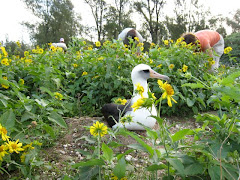 The many shades of Midway awaken the senses, never before have you seen so many hues of blue. Underwater the vibrant colors jump out at the eyes, flashes of greens, oranges and pinks swim by as fish dart between the corals. Crystal clear waters gently lap the reef crests displaying the pristine reefs. Lace coral decorates the ocean floor along with huge sea cucumbers and bright red pencil urchins. The eager faces of the participants show the excitement which they can not contain.
The many shades of Midway awaken the senses, never before have you seen so many hues of blue. Underwater the vibrant colors jump out at the eyes, flashes of greens, oranges and pinks swim by as fish dart between the corals. Crystal clear waters gently lap the reef crests displaying the pristine reefs. Lace coral decorates the ocean floor along with huge sea cucumbers and bright red pencil urchins. The eager faces of the participants show the excitement which they can not contain.Today, the group was treated with the unique opportunity to swim in one of the last predator dominated ecosystems. Awestruck and intimidated by the vastness of turquoise blue waters, participants rode the U.S. Fish and Wildlife boat to our snorkel destination, Hotel Reef. The group could not wait to enter the water, excited by the chance to swim in the middle of an old volcano. Swimming in the surprisingly cool Monument waters the group swam the perimeter of the reef watching brightly colored uhu (parrot fish), mimicking the swift movements of the giant ulua (blue fin trevally) and admiring the healthy coral. Excited to share their snorkeling experiences, the group exchanged stories back on the boat and looked up the fish they saw in the ID books. Today’s snorkel excursion was just one of the many amazing activities offered this week. Teresia Teaiwa in Epeli Hau̒ofa ‘s We Are The Ocean quotes “We sweat and cry salt water, so we know that the ocean is really in our blood”.


photo credits: Carlie Wiener

















